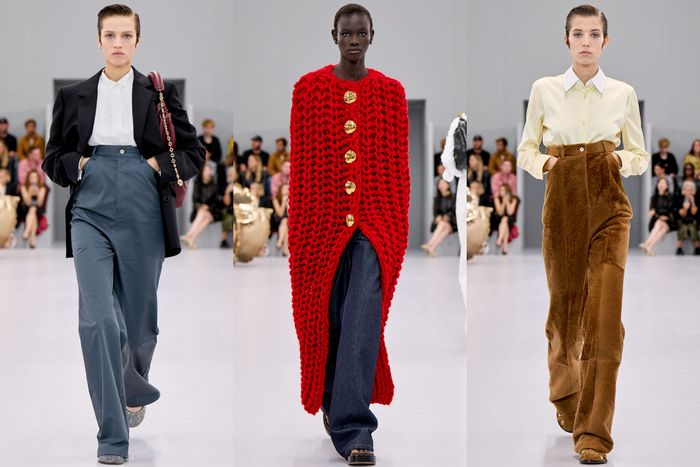
Yohji Yamamoto’s show last night in Paris could be broken down into five parts that add up to the same point, a point few designers know how to get to. There were the opening, loose-fitting suits and dresses in black cotton with sleeves of ivory, and then black men’s vests with low-slung black trousers that were finished with delicate silver chain belts, followed by a singularly beautiful long black column with a wide band of ivory, as stiff as horsehair, looping once or twice through the neckline and then trailing down one side. The fourth key style, again in black, consisted of coats and dresses that looked broken — that is, the mid-section of each was made of squares of fabric connected by black cloth tape, allowing the skin to show through. Yamamoto ended the show with six variations on a long, slim, plain black dress.
In the context of the Paris spring shows, you could be forgiven for thinking those final dresses had all the charm of a prison matron’s uniform. But Yamamoto, who turns 80 next week, expressed a different idea with this magisterial collection: Feeling a sense of power and protection in your clothes isn’t about imposing silhouettes or being covered up or flaunting provocative decoration. Protection is actually not being aware of your clothes. That’s what Yamamoto conveyed.
In the last few days, other collections seemed to drive toward the opposite belief, creating a manic muddle. Kendall Jenner, her hair teased into a Texas-size bouffant, closed Daniel Roseberry’s Schiaparelli show, in a red beaded strapless dress. A white lobster, almost equal in size to a three-pounder from Maine, crawled up the crotch of white draped pants, while the shoulders of a black mini coat-dress, worn by Shalom Harlow, were as fearsome as her blunt, black wig, shades of Mia Wallace in “Pulp Fiction.”
“I was inspired by this article about Zoran, by the title, ‘The Wizard of Ease,’ Roseberry said, referring to the great minimalist designer known for making clothes without buttons or zippers, and in a concise selection of high-quality fabrics and colors. “And I thought, Why don’t we bring that ease to Schiaparelli — this Americanism into the Place Vendome.” Roseberry’s clothes – adorned with gold bijoux-like buttons and chains, and with some skirts draped into awkward sarongs – weren’t exactly easy. But the direction toward sportswear — with jeans and gold-tipped hightop sneakers — will certainly give him more room to play.
That same day, on the plaza of the Palais de Tokyo, with jets of hot pink and yellow smoke coming from one direction and a blast of fresh rose petals from another, Rick Owens presented his collection of strict skirts, jackets and pants in leather and denim. The clothes were like second skins, the collars of some jackets protectively obscuring the face. Some models also wore gloves and matching net hoods, like runway beekeepers. The designer’s signature platform boots now featured padding on the calves.
Noting that he tends to “express resignation,” Owens said this collection was about wanting to capture joy and love. To that end, he asked Diana Ross if he could remix her song “I Still Believe in Love.” The beat pounded through the Paris neighborhood. But the covered-up looks — from a designer who has previously stripped things away — could also be read as armor and protection.
On Friday morning, Jonathan Anderson of Loewe sent out long, cocooning wool cardigans that functioned more as arm-constraining capes and a series of trim blazers with unmatched trousers cut higher on the waist than your great-grandpa’s. He also had a pair of baggy leather shorts run through the front waistband with a gold knitting needle. The artist Lynda Benglis contributed gold sculptures to the show and designed a new fine jewelry collection for Loewe. And some of Anderson’s recent work has referenced Surrealism, so the needle was probably intended in that vein, not as a threatening object. But it’s open to interpretation.
As for his high-waisted pants and blazers, some in classic men’s fabrics, Anderson said, “The proportion looks new to me.” It does indeed, and it’s great to see Anderson include so many fantastic colors, especially for cropped hand-knit pullovers. He called the overall shift away from his more experimental designs of the last two or three seasons “a compact luxury.” A good term. And it does feel ready to travel. Still, it’s fashion that doesn’t feel completely confident and brave in its own skin.













